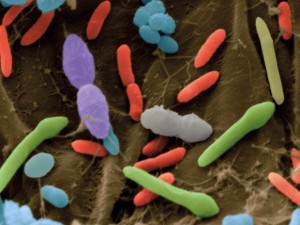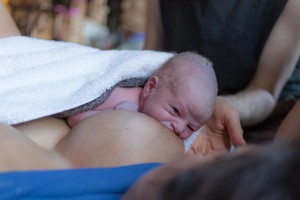Editor’s note: Several scientific studies were published this year on the topic of breastmilk’s effect on the establishment of healthy gut flora. This World Breastfeeding Week, Attachment Parenting International (API) gives a special thank-you to API Editorial Review Board member Linda F. Palmer, DC, for this modified excerpt from her new book, Baby Poop: What Your Pediatrician May Not Tell You
, which gives an overview of how our choice to breastfeed or not — or to provide expressed breastmilk or donor breastmilk if breastfeeding is not an option — can affect our baby’s health not only through childhood but long into adulthood.
Born from an entirely protective environment where mother’s body tends to baby’s every immune and nutritional need, breastfeeding transitions the newborn safely into childhood. Nutrition is truly only a portion of breastfeeding’s role. Along with significant neurological and hormonal provisions, there are multitude immune-protective factors. A major, but seldom considered, portion of baby’s protection from illnesses, and the continued health of the child, comes from the early establishment of optimal gut flora.
Editor’s note: Watch this video from National Public Radio to learn more about what your gut has to do with your health.
In the Beginning
Beginning with the trip through the birth canal, every minute counts in the early effort to launch the healthiest-possible balance of gut microbes. The newborn digestive system is not ready at birth to handle much in the way of food, and the breasts know this. Immune protection is the first order of business and is greatly dependent upon the establishment of healthy flora. When uninhibited by antibiotics, formula supplements or delayed feedings, breastmilk can essentially seal the deal.
 It’s been shown that the health of the floral environment into which an infant is born can have positive or negative impact on the creation of his long-term microbiome. In turn, the child’s early risks for infectious diseases, and adult risks of non-infectious diseases, are highly dependent upon early gut health. Remember that some hospital germs are much tougher than community germs, and quite antibiotic resistant. Also, if mother has not been in the hospital herself for a few days, her immune system — and hence her breastmilk — will not contain antibodies to many of the threatening microbes floating around the hospital. Infants born into large hospitals are at greatest risk for colonization with unfriendly flora. Those born in a non-sterile home with healthy-gutted inhabitants — and with people or pets who go outside often — are shown to establish the healthiest array of florae.
It’s been shown that the health of the floral environment into which an infant is born can have positive or negative impact on the creation of his long-term microbiome. In turn, the child’s early risks for infectious diseases, and adult risks of non-infectious diseases, are highly dependent upon early gut health. Remember that some hospital germs are much tougher than community germs, and quite antibiotic resistant. Also, if mother has not been in the hospital herself for a few days, her immune system — and hence her breastmilk — will not contain antibodies to many of the threatening microbes floating around the hospital. Infants born into large hospitals are at greatest risk for colonization with unfriendly flora. Those born in a non-sterile home with healthy-gutted inhabitants — and with people or pets who go outside often — are shown to establish the healthiest array of florae.
Editor’s note: API does not take a stance on homebirth, but rather advocates that parents make an informed choice on childbirth decisions. Learn more through API’s First Principle of Parenting: Prepare for Pregnancy, Birth and Parenting.
 If only a magical concoction existed with which a newborn’s digestive membranes could be quickly coated immediately after birth and then, if repeatedly applied, it could possibly head off some less desirable environmental influences. Of course, there is one. A few drops of colostrum from mother’s breast is all it takes — the sooner, the better.
If only a magical concoction existed with which a newborn’s digestive membranes could be quickly coated immediately after birth and then, if repeatedly applied, it could possibly head off some less desirable environmental influences. Of course, there is one. A few drops of colostrum from mother’s breast is all it takes — the sooner, the better.
The newborn’s stomach acidity at birth is quite neutral, because it contains amniotic fluid. Acidity does not become higher for about a day, so either good flora provided in colostrum or bad flora from a hospital environment have an exceptionally high opportunity to establish themselves in the first many hours after birth.
The Broncho-Entero-Mammary Pathway
Interestingly, when birth occurs through a planned Cesarean section — meaning no labor has occurred — mother’s milk is found to contain less healthy flora to pass to her newborn. Apparently, labor is not only a signal for mother’s placenta to pump antibodies into the soon-to-be-born child, but also a signal for the conveyance of important flora to mother’s breasts to enhance her colostrum for added newborn protection.
In addition to antibody-producing cells making their way from mom’s lymph centers in her intestines and respiratory tissues to her breasts, flora also travel from these areas to mother’s milk. Clearly, mother’s own gut health will impact what flora are available. These immune system cells and healthy bacteria are found to travel — transported by dendritic cells — chiefly through the lymphatic system as well as through the bloodstream. These roadways — by which mother’s body provides such valuable factors to her milk — are referred to as the broncho-entero-mammary pathway.
Mother’s milk not only provides more than 700 different species of valuable bacteria and fungi to homestead in her infant’s gut, but also plenty of special fiber-like sugars — oligosaccharides — to perfectly feed the flora. Every breastmilk taste provides a nurturing boost to the child’s floral garden.
Microbes — good or bad — will generally enter a child’s system through the mouth, pass through the throat and enter the intestines; thus, the digestive system is a baby’s greatest vulnerability, by far, in terms of infections. Auspiciously, breastmilk travels this same course and has tremendous influence on the development, wellbeing and protective capacities of the digestive tract and its flora — and thus the child. Even microbes that enter through a child’s nose will meet with breastmilk-nurtured floral defenses in the throat. The floral balance, and thus the infection risks for the sinuses and ear canals, depend upon the mouth and throat flora, which are influenced by the gut flora and by the same factors that affect gut flora — mainly breastmilk. Even lung flora and function are strongly influenced by the gut microbiome. Via its passage through the baby, breastmilk powerfully protects against dental, sinus, ear, throat, lung, stomach and intestinal infections.
Lactoferrin, Iron and Infant Protection
 Lactoferrin is a breastmilk protein that binds with iron. Nutritional iron is provided by mother’s milk in this bound manner. The more challenging bacteria — found in the gut of formula or solid-food-fed infants — require free iron to survive and proliferate. Lactoferrin holds on to the iron in the exclusively breastfed intestine, making the iron unavailable to feed unwanted bacteria and providing safe haven for desirable lactobacilli, bifidobacteria and other friendly microbes to proliferate.
Lactoferrin is a breastmilk protein that binds with iron. Nutritional iron is provided by mother’s milk in this bound manner. The more challenging bacteria — found in the gut of formula or solid-food-fed infants — require free iron to survive and proliferate. Lactoferrin holds on to the iron in the exclusively breastfed intestine, making the iron unavailable to feed unwanted bacteria and providing safe haven for desirable lactobacilli, bifidobacteria and other friendly microbes to proliferate.
Once free iron is added to a breastfed child’s diet, it will saturate and overwhelm the lactoferrin, feeding the challenging bacteria and allowing them to flourish. Free iron exists in all formulas — even low-iron formulas — and pretty much in any solid food besides pure fats or refined sugars. It doesn’t take very much formula, juice or baby food to overtake the protective lactobacilli and bifidobacteria florae provided by exclusive breastmilk feeding and to allow for the growth of the more challenging types of bacteria, including enterococci, enterobacter, clostridia, streptococci and E. coli. In fact, baby’s flora has been shown to change within 24 hours after just one bottle of formula.
The picture, of course, isn’t quite as simple as this. Various proteins, such as isolated soy or cow milk proteins, are also known to interrupt the virgin flora of a previously exclusively breastfed gut. Once your infant’s stools begin to develop unpleasant odor and darken in color, you can tell that the floral transition from protective breastfed flora to more adult-like bacteria is taking place.
A final loss of the exceptionally protective flora that only exclusive breastmilk provides is inevitable with the eventual introduction of solid foods. The longer this event can be put off, however, the longer the child’s status of lower risk for infections can be maintained and the stronger his future protection becomes. Six or more months before introducing other foods is the recommended goal. Still, after this flora alteration occurs, breastfeeding continues to provide many, many nutritional, hormonal, neurological and immune protective advantages and continues to support the flora.
Final Thoughts
Many mothers have an ideal image of the way they want their baby’s beginnings to be. Often, things don’t go as intended. All is not lost. The good news is that recent studies are revealing that when all doesn’t go as planned, positive impacts can be made on baby’s flora and intestinal health with the use of probiotics and other healing measures, thereby reducing later risks of many chronic diseases.
Editor’s note: Citations and further information, including the impact of antibiotic use among infants, can be found in the book Baby Poop.
